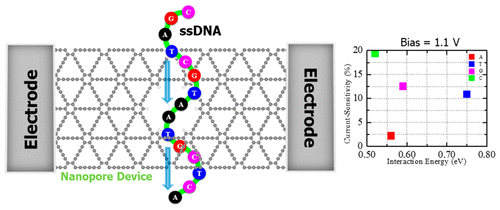当前位置:
X-MOL 学术
›
ACS Appl. Electron. Mater.
›
论文详情
Our official English website, www.x-mol.net, welcomes your
feedback! (Note: you will need to create a separate account there.)
Electronic Conductance and Current Modulation through Graphdiyne Nanopores for DNA Sequencing
ACS Applied Electronic Materials ( IF 4.3 ) Pub Date : 2021-08-20 , DOI: 10.1021/acsaelm.1c00452 Rameshwar L. Kumawat , Biswarup Pathak
ACS Applied Electronic Materials ( IF 4.3 ) Pub Date : 2021-08-20 , DOI: 10.1021/acsaelm.1c00452 Rameshwar L. Kumawat , Biswarup Pathak

|
Solid-state nanopore devices have emerged as one of the most promising technologies that may decode the sequence of DNA nucleobases by reading electronic conductance and electric current signals. Herein we study the potential of atomically thick graphdiyne (GDY) to act as an all-electronic nanopore (NP)-based DNA sequencing device. The first-principles density functional theory method is used to study the structural properties, interaction energy (Ei) values, translocation time (τ), charge transfer [Q(e)] values, charge density difference [Δρ(r)], molecular orbital (MO) positions, and electronic density of states (DOS) properties of the GDYNP and GDYNP + nucleobase (nucleobases: adenine (A), guanine (G), thymine (T), and cytosine (C)) systems. Our results suggest that the GDYNP system could be a suitable device for the detection of nucleobases due to their specific translocation times inside the GDYNP device. The Δρ(r) results reveal that the charge fluctuates around the GDYNP edges close to the target nucleobase. This charge reorganization causes the modulation of charge transport in the GDYNP device. Furthermore, the GDYNP device is used to read-out the conductance and current signals of each DNA nucleobase while located inside the GDYNP by using nonequilibrium Green’s functions formalism. Our findings show a change in conductance with respect to the reference bare “GDYNP” device for energy values below/above the Fermi energy. The conductance as well as current sensitivity (%) values (C > G > T > A) indicates that the nucleobases could possibly be sequenced through the GDYNP device. Further, each nucleobase transmits unique current signals when transported through the GDYNP device. A distinction between purine- and pyrimidine-type nucleobases seems possible due to their different current signals. Thus, our study highlights the potentials that would motivate research toward the development of the GDYNP device, which may be even a better DNA nucleobase detector compared to graphene-based devices.
中文翻译:

用于 DNA 测序的石墨炔纳米孔的电导和电流调制
固态纳米孔装置已成为最有前途的技术之一,它可以通过读取电导和电流信号来解码 DNA 核碱基的序列。在此,我们研究了原子级厚石墨炔 (GDY) 作为基于全电子纳米孔 (NP) 的 DNA 测序设备的潜力。第一原理密度泛函理论方法用于研究的结构特性,相互作用能(Ë我)值,易位时间(τ),电荷转移[ Q(ë)]的值,电荷密度差Δρ(ř)]、GDYNP 和 GDYNP + 核碱基的分子轨道 (MO) 位置和电子态密度 (DOS) 特性(核碱基:腺嘌呤 (A)、鸟嘌呤 (G)、胸腺嘧啶 (T) 和胞嘧啶 (C))系统。我们的结果表明 GDYNP 系统可能是检测核碱基的合适设备,因为它们在 GDYNP 设备内具有特定的易位时间。Δρ( r) 结果表明电荷在靠近目标核碱基的 GDYNP 边缘周围波动。这种电荷重组导致 GDYNP 器件中电荷传输的调制。此外,GDYNP 设备用于通过使用非平衡格林函数形式来读出位于 GDYNP 内部的每个 DNA 核碱基的电导和电流信号。我们的研究结果显示,对于低于/高于费米能量的能量值,相对于参考裸“GDYNP”设备的电导发生变化。电导和电流灵敏度 (%) 值 (C > G > T > A) 表明可以通过 GDYNP 设备对核碱基进行测序。此外,当通过 GDYNP 设备传输时,每个核碱基都会传输独特的电流信号。由于其不同的电流信号,嘌呤和嘧啶型核碱基之间的区别似乎是可能的。因此,我们的研究强调了推动 GDYNP 设备开发研究的潜力,与基于石墨烯的设备相比,GDYNP 设备可能是更好的 DNA 核碱基检测器。
更新日期:2021-09-28
中文翻译:

用于 DNA 测序的石墨炔纳米孔的电导和电流调制
固态纳米孔装置已成为最有前途的技术之一,它可以通过读取电导和电流信号来解码 DNA 核碱基的序列。在此,我们研究了原子级厚石墨炔 (GDY) 作为基于全电子纳米孔 (NP) 的 DNA 测序设备的潜力。第一原理密度泛函理论方法用于研究的结构特性,相互作用能(Ë我)值,易位时间(τ),电荷转移[ Q(ë)]的值,电荷密度差Δρ(ř)]、GDYNP 和 GDYNP + 核碱基的分子轨道 (MO) 位置和电子态密度 (DOS) 特性(核碱基:腺嘌呤 (A)、鸟嘌呤 (G)、胸腺嘧啶 (T) 和胞嘧啶 (C))系统。我们的结果表明 GDYNP 系统可能是检测核碱基的合适设备,因为它们在 GDYNP 设备内具有特定的易位时间。Δρ( r) 结果表明电荷在靠近目标核碱基的 GDYNP 边缘周围波动。这种电荷重组导致 GDYNP 器件中电荷传输的调制。此外,GDYNP 设备用于通过使用非平衡格林函数形式来读出位于 GDYNP 内部的每个 DNA 核碱基的电导和电流信号。我们的研究结果显示,对于低于/高于费米能量的能量值,相对于参考裸“GDYNP”设备的电导发生变化。电导和电流灵敏度 (%) 值 (C > G > T > A) 表明可以通过 GDYNP 设备对核碱基进行测序。此外,当通过 GDYNP 设备传输时,每个核碱基都会传输独特的电流信号。由于其不同的电流信号,嘌呤和嘧啶型核碱基之间的区别似乎是可能的。因此,我们的研究强调了推动 GDYNP 设备开发研究的潜力,与基于石墨烯的设备相比,GDYNP 设备可能是更好的 DNA 核碱基检测器。











































 京公网安备 11010802027423号
京公网安备 11010802027423号